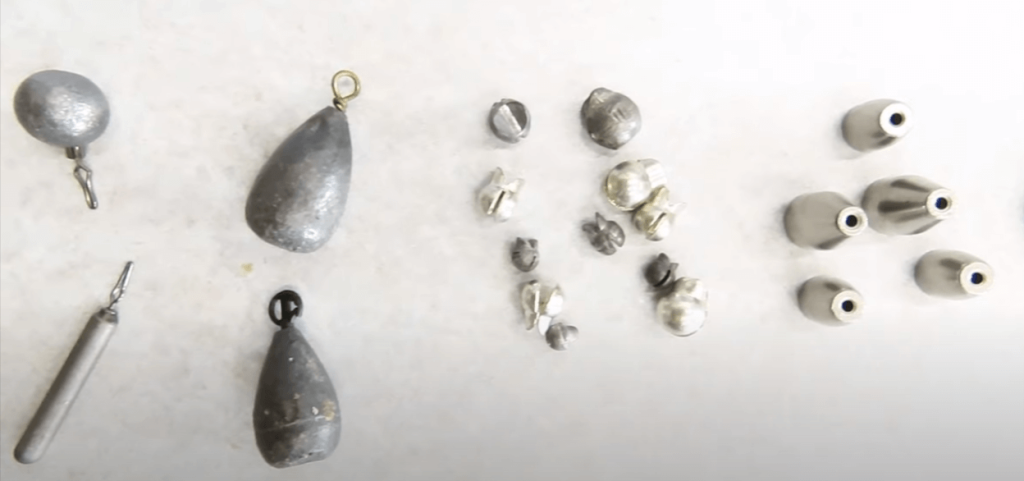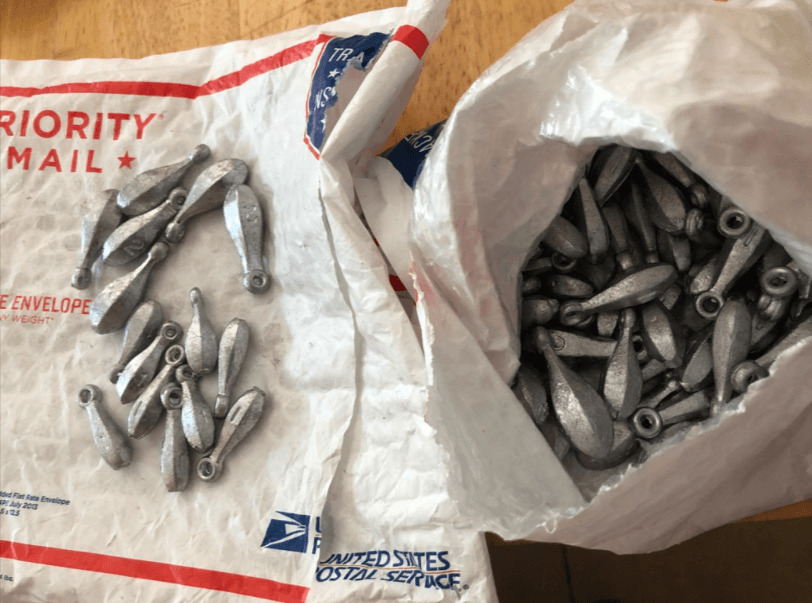Using weights or sinkers is familiar to anglers. However, this will be a challenge for new players who need help figuring out what to do with the sinkers they have.
In this article, I will list some common sinkers, explain when you should use sinkers, and finally, how to tie sinkers on the fishing line.
Contents
What are sinkers?
Weights on a fishing line, also known as a sinker, are objects made of lead with a certain weight, used to tie or clip to the fishing line to help the bait sink to a certain depth. The weight or size of each sinker usually depends on conditions such as water depth, bait size, and current intensity.

Sinkers or also known as weights
What kind of sinkers are on the market?
Depending on the different types of sinkers, they will have other functions. I will list them as precisely as possible.
Bullet Weights
Bullet Weights are one of the most popular types of sinkers, and they look just like their name suggests. They are designed with a long bullet body and a small hole on the top of the head to let the fishing line pass through.
Bullet weights are most effective when fishing in heavy vegetation or around thick grass. Of course, they will be very suitable for bass fishing and used with soft plastic and artificial baits.
They are also excellent for children and beginner fishermen of all ages because they are so easy to use. Additionally, they can work with various techniques, baits, and lures. And, of course, you don’t need to know any unique knots to secure this fishing weight to the fishing line.
Egg Weights
Unlike bullet weights, egg weights are also quite commonly used in bass fishing, with their design allowing the line to move freely through them. Egg weights are great for keeping your bait close to the bottom, especially when targeting fish at great depths.
However, you must find the right size of the egg weights through experimentation. Otherwise, there will be an ironic situation where using pellets that are too small may not hold the bait in the desired position, while using a weight that is too large can make it difficult to feel the bite. This weight is ideal for fishing without a fishing rod or providing versatility when using a Carolina rig.
Flat or Coin Weights
Coin-shaped pellets are suitable for shore fishermen or anglers who prefer a sit-and-wait approach, so they are rare. While you wait to see signs of a bite from a float or float, they are often used with a float or float, helping to hold the bait or trap in place.
Additionally, they are not easily moved by currents, tides, or the movement of fish or other organisms in the water. Thanks to the coin’s flattened design, this makes them suitable for ocean fishing. Besides, they allow you to choose the depth at which the bait or weight hangs from the pellet. Anglers often use them when freshwater, sea fishing, or in areas with strong currents or tides that can quickly move other fishing tackle.
Pyramid Weights
Designed in a unique triangular shape with a pointed tip, pyramid weights are considered best for quickly getting your bait to the deep lake bottom while keeping it there even in strong currents. It is a fact that shore fishermen often use pyramids more heavily than boat fishermen. Additionally, pyramid weights are usually more expensive than other types, costing around $10 for small ones and even around $20 or more for larger ones.
Split-Shot
Using a split shot weight may be the right choice if you are looking for a weight that can handle different fish species in freshwater and deep sea fishing. They are also prevalent among the fishing community because of their flexibility in different situations. Additionally, they are affordable and accessible to add or remove to adjust the weight of your fishing line.
Others
Of course, there will be different types of weights, for example, pencil weights, walking weights, drop-shot weights, nail weights, and rubber-core weights. Each type will be suitable for different functions and have other characteristics. Specifically, rubber core sinkers are used for bottom fishing and reduce line damage and noise, while pencil weights are often used for freshwater fishing for species such as catfish, bass, and panfish.
When to use weights on fishing line?
If you want your fishing to be more convenient when your bait can sink deeper and attract more fish, weights fishing line will be a great choice. They will help your bait drop into deeper water, making fish more likely to strike. The usual weight will be from 6 to 10 pounds; their price will vary depending on the shape and usage.
Fish can hide significantly more profoundly than your light hook can sink in deep water. Thanks to the weight, you control exactly how deep your bait will fall.
Additionally, you will get excellent stability when the water below flows at high speed by fishing weights or passes through different currents. In cases where there is too much variation in speed between different layers of water, it helps keep your bait stable. Most notably, it will hold the hook in its original position when the fish grasps the bait and begins to move. Therefore, having fishing weights is helpful for anglers on many levels.

When to use weights on fishing line?
What factors should be considered when using weights?
One of the factors that can make a significant difference in your success when fishing is choosing the right fishing weight. Determining the ideal weight for your setup considers factors such as water conditions, fish species, bait, and fishing technique.
- Start by assessing the water depth and current, affecting how much weight you need to keep the bait at the desired depth. Lightweight suits shallow or slow currents, and heavy weight is needed for deep or fast currents.
- Then, consider the species of fish you’re targeting and whether they like the bait at that depth. To make it easier to imagine, I will make the following comparison: bottom fish like catfish or carp will often need a heavy weight to keep the bait close to the bottom. Meanwhile, the light amount will suit predatory fish such as bass or pike that lunt near the surface.
- Besides, find a weight that is appropriate for the bait you use. Weighing your bait too heavily will prevent it from sinking too quickly and becoming ineffective while using a weight that is too light will prevent your bait from reaching the desired depth.
- Furthermore, consider what fishing technique you will use. For example, when using shad baits, you must use a heavy weight to hold the bait at the desired depth but not so heavy as to pull the shad underwater.
- Ultimately, you’ll find the perfect fit for your setup as you experiment with weights. Feel free to make adjustments when water conditions or fish behavior changes.
How to put weights on fishing line?
Preparing the equipment and weights
Before installing weights on the fishing line, it is necessary to prepare the required items. You need to have appropriate weights for the hook and lure. Besides, there are hooks and lures because they will help you balance the weights correctly. Finally, there’s the fishing line, as long as it suits your fishing purpose.
Putting weights on fishing line
Attach weights to your fishing line one at a time. Remember to incorporate a free slide in the fishing line. This is ideal for fishing in currents or at varying depths. You can also use a swivel hook, which helps prevent your fishing line from twisting. Anglers often use multiple hooks or lures to help prevent tangles, benefiting them.
Then, consider where to place the weights. With floating baits or lures, the weight will usually be placed near the hook to hang at the correct depth. In contrast to sinking baits or lures, weights are often placed farther away so the bait sinks more slowly.
Tiding your hook
Fishing hooks will be the final highlight because they are essential in making a difference when fishing. The hook size is usually moderate and should match your bait or lure size when fishing and your fishing goals.
Second, you need to consider the style of the hook. Catch-and-release fishing will work well with loop hooks because hooking the fish at the corner of the mouth instead of the belly makes it easier to release the fish without causing too much damage. In contrast, the J hook will operate flexibly in many different situations.
Afterward, you must tie a simple knot once you’ve chosen the right hook. Then, bring the end of the line through the eye of the hook and tie a dead knot around the main line, pulling tight to secure the hook. This will help the fishing line withstand the best pressure during fishing.
Testing weights by casting a fishing line
This helps you know whether your fishing line can work adequately in combat. Try to find a place right near the fishing area and cast your fishing line far away; this will help you feel the effectiveness of the weight. If you are unsatisfied, you can change weights or hooks.
Wrap up
Sinkers are familiar, but if you know how to use them when fishing, you will quickly catch more fish. In addition, try to choose sinkers that suit your criteria. Please let me know if this article is helpful. Hoping to see you in the following articles.

